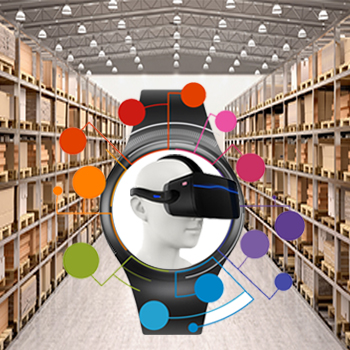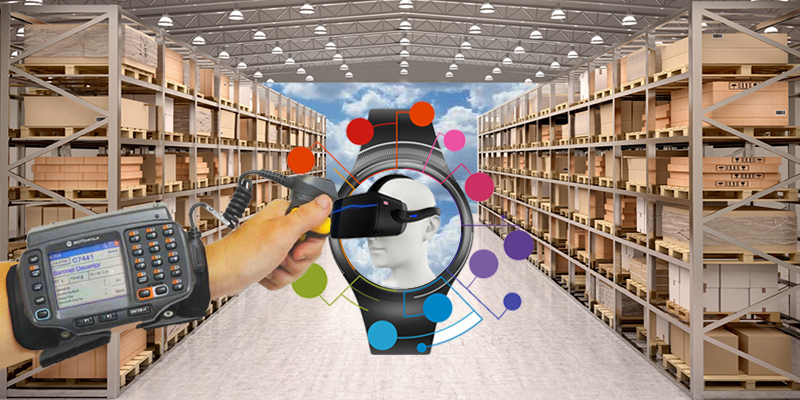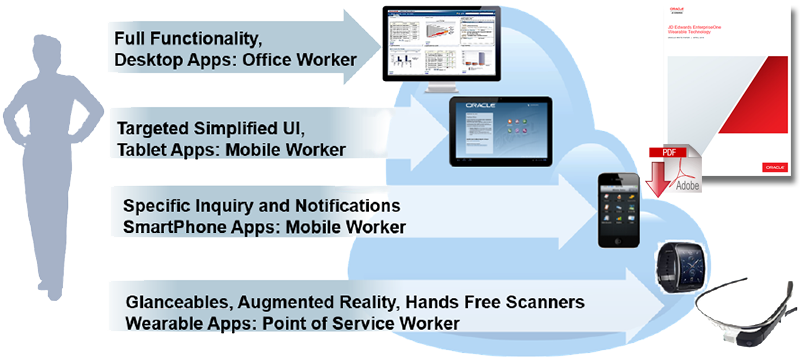The next wave of manufacturing innovation will come from the Internet of Things.
Indeed, connected networks of factory hardware are already enhancing process transparency and enabling previously untapped analytics in several plants.
Wearable technologies have the opportunity to further improve operational efficiencies.
Also known as wearables, the term refers to devices, often connected to the Internet or to other devices that are worn on the body and can be used to enhance communication to and from the users.
Wearables are likely to be adopted quickly, given the potential benefits in communication, productivity, and safety - and depending on the type of technology that’s employed.
For example, communication can be improved through smart glasses or voice command devices. Step-by-step manufacturing instructions can be transmitted visually through smart glasses, while two-way audio headsets can give users real-time notifications pertinent to their activities on the floor.
Productivity increases from wearable voice command tools can increase factory warehouse efficiencies up to 30 percent, according to vendors of the technology. Other wearables can monitor health and stress levels of employees through fitness trackers, while GPS and beacon technology can easily locate employees and prevent them from entering a dangerous zone, such as machine cages and boilers.
Work Metaphors in the Post-PC Era Optimized by Device
If you stretch your imagination and go back a few decades, mainframe computers were the dominant form of enterprise computing and occupied the physical space of a room.
During the next stage of the computer evolution, mainframes evolved into a client-server architecture, with clients running as desktops and servers running as towers or domes. Following Moore’s Law, computers have become smaller while providing the same or greater computational and memory capability.
Today’s tablets and smartphones can fit inside a purse or pocket while providing greater capability than the desktop computers of yesteryear.
This process is comparable to the evolution of timekeeping devices, which advanced from community-wide clock towers to pendulum clocks to pocket watches to wrist watches to a point where many carry no watch at all, but rely on mobile technologies.
The success of each version was judged by how well each device helped users tell time. Just as clocks shrank from giant towers to smaller devices on our wrist or phone, computers have evolved from colossal size to a wearable design. This unrelenting march towards miniaturization provides us with a new platform aiming to provide us with the most pleasing and intuitive design to make our interaction with the computer seamless.
This is the advent of wearable computing.
Download the Paper: JD Edwards EnterpriseOne Wearable Technology
Let’s take a look at some of the wearable technologies that are likely to change the way you operate on the factory floor in the future.
On Your Head…
While smart glasses largely remain a niche in the consumer market, many of their capabilities can be put to good use in industrial settings.
Smart glasses decouple operators from stationary terminals and paper documentation. For example, pick-by-vision provides benefits in operator safety and ergonomics by allowing operators to be hands free.
It also increases efficiency by eliminating paper or stationary terminals, and increases accuracy by visually confirming via scanning. Another smart glasses application is remote video conferencing, which is emerging in field service industries because it increases asset uptime and reduces support cost by remotely supporting operators using cameras, instead of having them wait on a technician to arrive. Smart glasses can also decrease training lead times, improve quality rates, and reduce cycle times in assembly operations.
Voice control headsets are one of the oldest wearable technologies and have been in use in industrial settings for more than a decade.
Today, this technology is used almost exclusively in warehousing applications such as piece picking; verbal commands direct operators to a picking location, tell them what quantity to pick, and where to place the picked items. Often, the device software links with existing ERP software, allowing real-time inventory updates and progress.
So it’s not a big leap for these warehouse applications to make their way into a manufacturing environment such as an automotive plant. Where older devices rely on radio frequency (RF), newer generations of voice control headsets can use WiFi so that, combined with location detection, they can provide for much more flexible applications (for example, materials handling in plants).
Because WiFi modules are now inexpensive, allow for easy setup of applications, and integrate easily with existing network security, they will most likely be the better option for manufacturers looking to “get their feet wet.”
…Or on Your Wrist
The recent explosion of fitness bands and smart watches lets users better monitor their health and fitness levels and communicate with the world around them.
The fitness bands on the market today use biometrics that detect and monitor a user’s heart rate, determine how many calories the user burns, or how well the user sleeps.
Smart watches share many of the capabilities of fitness bands, but with more communication functionality because they’re typically integrated with a smartphone and can display text messages, e-mails, and calls without needing to access the phone. They also operate many of the same applications as smartphones.
Both of these devices present interesting opportunities for the factory floor. For example, the pedometer technology in the fitness bands can measure efficiency and ergonomics by tracking the steps required to execute particular operations.
This data can then be used in simulation software to further optimize the storage locations of tools and parts in order to minimize movement, similar to how you once videotaped changeovers to reduce setup times. The GPS functionality in these devices may prove increasingly useful from a safety point of view as location-based applications can automatically shut down robots or machines when employees are in danger, including stopping a forklift that is rounding a blind corner.
In addition, employee biometrics could be monitored to identify which operations or situations cause excessive exertion on an operator that could result in future injury. QR codes on parts, ingredients, or along process steps may provide traceability and help maintain inventories. Or, instead of using clunky barcode scanners, employees could use their smart watch to easily update locations and quantities of inventories.
Finally, transactional operations that typically require computer terminals or barcode scanners may now be performed in-line.
Security Concerns
As wearables gain a foothold in manufacturing, security concerns will have to be addressed. The same security concerns inherent in other digital applications apply, including phishing, malware attacks, and network overloads.
Wearables collect specific data for manufacturing use, but they never turn off, collecting extraneous data that could be harmful if used incorrectly. Privacy is also a concern because wearables can be used to collect data on personal habits, behaviors, and the health of employees.
Making this data secure, and abiding by government standards, is of paramount concern if wearables are to become widespread. Addressing these includes a variety of tactics, starting with secure software and hardware development, and by creating proprietary tools that cannot easily be infiltrated. The judicious deployment of devices (including role-based access and specific user privileges) is another way to improve security.
Ready or Not
There is an opportunity for manufacturers to achieve both tangible and intangible benefits from leveraging wearable technology. However, there are several considerations before implementing a wearable solution in your factory.
Wearable devices are still relatively new. The consumer applications in this space have only emerged in the past three to four years, and the limited products that are available still have some shortcomings that need to be addressed to make them suitable for industrial applications.
First of all, consumer products are not designed or tested to endure the everyday wear and tear of industrial operations, so wearables need to be adapted to ensure structural integrity. Battery life is also a concern as some of these devices, particularly smart glasses, do not currently have enough battery life to last a full manufacturing shift.
Finally, many factories do not have full Wi-Fi coverage on the factory floor, or may not have the bandwidth to handle full-scale wearables deployment, so manufacturers should ensure their network infrastructure is prepared to accommodate new devices.
Wearables suppliers also need to address cost. Because most of today’s devices are designed to accommodate consumer preferences and needs, their functionality is probably exaggerated for the shop floor and developers should “de-scope” functionality to reduce the price. But, with the proliferation of the Internet of Things, most manufacturers will already have the systems, resources, and knowledge in place to accommodate at least some wearable technologies.
Unlock the Benefits
The adoption of wearable technology on the shop floor has the potential to tap new areas of improvement across industries. Smart glasses, voice control headsets, fitness bands, and smart watches are only the beginning of this next phase of industrial modernization.
To realize the full benefits, manufacturers need to look at wearables not just as a gimmick to modestly improve upon activities that are already done with other tools and technologies. Instead, they should be seen as a tool to capture a combination of connected data (for example, location info, biometrics, and product data) that is otherwise hard to come by.
Analyzing this data for trends and improvement opportunities has the potential to unlock otherwise hard-to-identify benefits, both for employees and employers.
About the Authors
Patrick Van den Bossche is a partner with A.T. Kearney and is part of the firm’s global operations practice. He is based in Washington, D.C.
Christopher Simpson, Daniel Weiser, and Nick Anderson are consultants with A.T. Kearney.
Related: Avoiding Security Faux Pas with Wearable Tech

Article topics
Email Sign Up



















